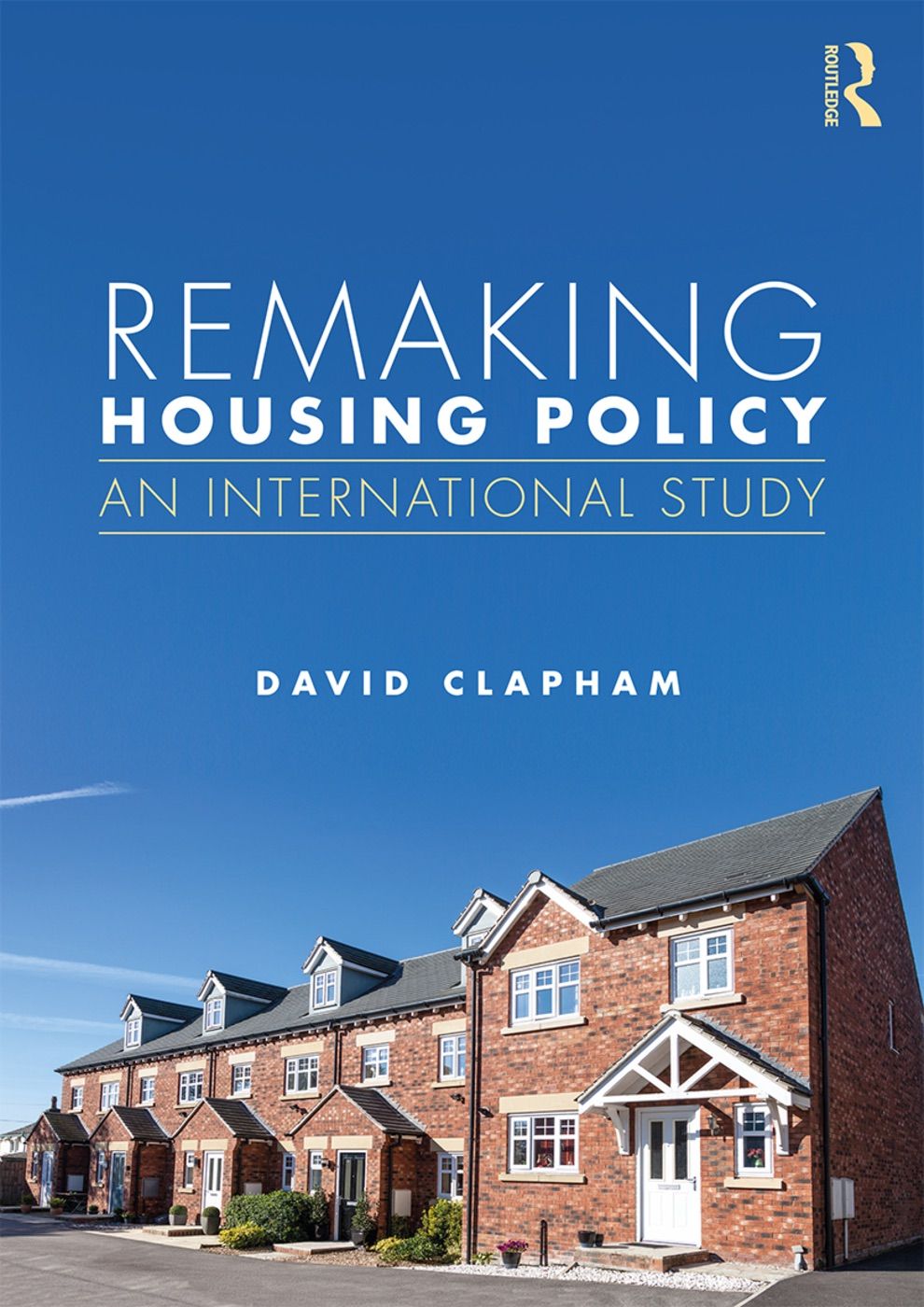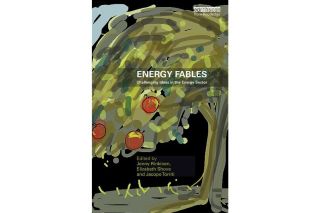
www.buildingsandcities.org/insights/reviews/remaking-housing-policy.html
Remaking Housing Policy: An International Study
By David Clapham. Routledge, 2019, ISBN: 9781138193956
 Elanor Warwick reviews this book which critiques
neoliberal approaches to housing and provides alternative, emergent ideas for
housing policy. With her background in academic, local government and public
sector built environment research (Commission for Built Environment - CABE), Elanor
currently leads the research and policy team for Clarion Housing Association,
UK.
Elanor Warwick reviews this book which critiques
neoliberal approaches to housing and provides alternative, emergent ideas for
housing policy. With her background in academic, local government and public
sector built environment research (Commission for Built Environment - CABE), Elanor
currently leads the research and policy team for Clarion Housing Association,
UK.
In a recent blog David Clapham asks whether housing academics can remain as "neutral observers" providing value-free insight to be used as levers to shift political and popular opinion.
Clapham's new book asks what better housing policy might look like. He sets out to suggest alternatives to current dominant neoliberal views, exploring housing policy founded on improving the welfare of the individual. This is based on four undisputable principles; housing as a right, increased wellbeing, equity and sustainability. The result is an even-handed (but clearly not neutral) meta-review of international housing policy. He highlights common bleak outcomes; rentier-owned under-regulated homes with high rents, house price appreciation, ineffectual deregulation and competition between housing providers, all leading to housing shortages, growing incomes and wealth disparity, inequality and reduced well-being.
Housing academics / activists tend to emphasise distinct positions to strengthen their arguments and it is instructive to read Danny Dorling's or Anna Minton's fiery polemic reduced to a dispassionate half page on the redistribution of housing or the fight for the Heygate. This calm, objective tone, is similar to Clapham's earlier insightful book The Meaning of Housing: A Pathways Approach(Clapham, 2005) which Remaking Housing Policy updates and compliments. Both contain reminders that homes are emotionally charged objects, that residents aren't passive receivers of housing interventions but interact with policy via their individual struggles and household choices, dictated by context and agency.
The breadth of topics covered in the book (from housing justice to housing as a positional good, i.e. the timing of becoming a homeowner matters as it influences how much a household gains - recent home owners will benefit less than baby boomers) makes it an excellent overview for students or professionals. It explains pertinent concepts such as "affordance"; that homes have multiple social and cultural meanings, in addition to their practical utility providing shelter and security. The text is brisk as so much is covered: housing quality, homes as a commodity, or why the market doesn't behave in the ways neoclassical economists might like. This can lead to generalisations. All of the heated arguments underpinning the Nationally Defined Space Standard (extensively described in Park, 2017) are summarised in the line "the impact of space standards is contested" (p. 72). Insights such as this, or that the UK experience of using Section 106 planning conditions to provide social housing has delivered "real benefits in terms of reduced stigma" (p. 157) deserve further explanation (see Burgess, G, Monk, S. & Whitehead (2011) on the mechanisms of Section 106 or Markovich, (2015) on the stigma associated with mixed tenure housing). However, the pithy case studies are a strength. While it is unsettling to read the intense debate about the Grenfell Fire reduced to a handful of bullet points on trade-offs and competing regulatory interests (case study 5.3), it is refreshing to see the case for government intervention in secondary mortgage markets post 2008 distilled to a single page (case study 4.4).
For the last decade English Housing Policy has been in a state of constant flux, meaning some sections of the book will date better than others. Some of the actions called for in the homelessness chapter have already been enacted by the 2018 Homelessness Reduction Act. Chapter Three neatly summarises alternative housing regimes into a table of the pseudo similarities, welfare ideologies and institutional structures of the six countries cited (UK, USA, Sweden, China, Australia and Argentina). This is not a comparative urbanism study crammed with data and tables, and these countries are selectively used to illustrate different housing mechanisms, leaving the messy practicalities of policy transfer between countries (McCann & Ward, 2011) untouched. Chapter Eleven makes the important point that social housing practices are not sufficiently considered within sustainability policy, limiting housing's definition to "utilitarian concepts lacking moral and ethical dimensions" (p. 22). Yet for a book arguing that the two most significant challenges to housing policy are inequality and sustainability, the chapter on environmental sustainability might reflect on current convergence of intuitional and popular environmental movements with Extinction Rebellion and Committee on Climate Change (2019) taking similarly ethical stances
Anyone involved in housing policy will recognise how evidence-based policy has been displaced by rehashed, vote-chasing concepts and impulsive back-of-envelope policy formation. The recent re-emergence of rent to buy (masquerading as right to shared ownership) echoes Jamie Peck's (2010) narrative of "zombie neoliberalism". Peck argues, post the Global Financial Crash, that neo-liberalism is "dead but dominant", its policy reflexes continuing to twitch, surviving only through increasingly interventionist statecraft. Clapham's book usefully counters this forgetful policy formation with thorough historical case studies. Everyone concerned about social housing's future should read the decline of Sweden's housing success stories. Approaches such as soft rent controls (case study 8.4), residential sustainability (case study 11.2), right to shelter and municipal housing companies underpinned the shared belief in public housing for everyone (case study 9.3). However, after the removal of public sector rent benchmarking (case study 4.2) public and private rents diverged rapidly. Clapham argues it was the introduction of these neoliberal policy measures (interest subsidies, property taxation favouring homeowners and reduced housing allowances) that shifted Sweden from tenure neutrality to owner occupancy as favoured tenure (case study 8.5).
The range of neoliberal policies that Clapham catalogues all tend towards privatisation, marketisation, commodification, financialisation and, underpinning all of these trends, the individualisation of a housing unit rather than seeing homes as collectively valued community assets. The book works backwards from the final chapter, which starts to explore alternative regimes offering hope, for example Community Land Trusts. The challenge to address is clearly articulated, yet the proposed tools to make this change, the "language games", "discourse", "coalition building", even the "battle of ideas", seem too weak to overcome the strong vested interests the preceding eleven chapters describe. As Clapham acknowledges, escaping the dominant straightjacket of neoliberal thought is hard, especially when hampered by academic commitments to observational neutrality. Clapham sees limited prospects in existing policy mechanisms, noting that "various attempts to deal with the problems have made things worse" (p. 202). But he is optimistic that now is the time for change and if his alternative ideal housing policy isn't quite formulated yet, Clapham's lucid explanation goes a long way to ensure that emergent new ideas don't make the same mistakes as the past.
References
Burgess, G, Monk, S. & Whitehead, C. (2011). Delivering local infrastructure and affordable housing through the planning system: the future of planning obligations through Section 106 People, Place and Policy, 5 (1), 1-11
Clapham, D. (2005) The meaning of housing: A pathways approach. Bristol: University Press. https://policy.bristoluniversitypress.co.uk/the-meaning-of-housing
Committee on Climate Change (2019) UK housing: Fit for the future? https://www.theccc.org.uk/publication/uk-housing-fit-for-the-future/
Markovich, J. (2015) 'They Seem to Divide Us': Social Mix and Inclusion in Two Traditional Urbanist Communities, Housing Studies, 30:1, 139-168.
McCann, E. & Ward, K. eds. (2011). Mobile urbanism: Cities & policy-making in the global age. Minnesota.
Peck, J. (2010). Zombie neoliberalism and the ambidextrous state. Theoretical Criminology, 14(1), 104-110.
Latest Peer-Reviewed Journal Content
Acceptability of sufficiency consumption policies by Finnish households
E Nuorivaara & S Ahvenharju
Key factors for revitalising heritage buildings through adaptive reuse
É Savoie, J P Sapinski & A-M Laroche
Cooler streets for a cycleable city: assessing policy alignment
C Tang & J Bush
Understanding the embodied carbon credentials of modern methods of construction
R O'Hegarty, A McCarthy, J O'Hagan, T Thanapornpakornsin, S Raffoul & O Kinnane
The changing typology of urban apartment buildings in Aurinkolahti
S Meriläinen & A Tervo
Embodied climate impacts in urban development: a neighbourhood case study
S Sjökvist, N Francart, M Balouktsi & H Birgisdottir
Environmental effects of urban wind energy harvesting: a review
I Tsionas, M laguno-Munitxa & A Stephan
Office environment and employee differences by company health management certification
S Arata, M Sugiuchi, T Ikaga, Y Shiraishi, T Hayashi, S Ando & S Kawakubo
Spatiotemporal evaluation of embodied carbon in urban residential development
I Talvitie, A Amiri & S Junnila
Energy sufficiency in buildings and cities: current research, future directions [editorial]
M Sahakian, T Fawcett & S Darby
Sufficiency, consumption patterns and limits: a survey of French households
J Bouillet & C Grandclément
Health inequalities and indoor environments: research challenges and priorities [editorial]
M Ucci & A Mavrogianni
Operationalising energy sufficiency for low-carbon built environments in urbanising India
A B Lall & G Sethi
Promoting practices of sufficiency: reprogramming resource-intensive material arrangements
T H Christensen, L K Aagaard, A K Juvik, C Samson & K Gram-Hanssen
Culture change in the UK construction industry: an anthropological perspective
I Tellam
Are people willing to share living space? Household preferences in Finland
E Ruokamo, E Kylkilahti, M Lettenmeier & A Toppinen
Towards urban LCA: examining densification alternatives for a residential neighbourhood
M Moisio, E Salmio, T Kaasalainen, S Huuhka, A Räsänen, J Lahdensivu, M Leppänen & P Kuula
A population-level framework to estimate unequal exposure to indoor heat and air pollution
R Cole, C H Simpson, L Ferguson, P Symonds, J Taylor, C Heaviside, P Murage, H L Macintyre, S Hajat, A Mavrogianni & M Davies
Finnish glazed balconies: residents' experience, wellbeing and use
L Jegard, R Castaño-Rosa, S Kilpeläinen & S Pelsmakers
Modelling Nigerian residential dwellings: bottom-up approach and scenario analysis
C C Nwagwu, S Akin & E G Hertwich
Mapping municipal land policies: applications of flexible zoning for densification
V Götze, J-D Gerber & M Jehling
Energy sufficiency and recognition justice: a study of household consumption
A Guilbert
Linking housing, socio-demographic, environmental and mental health data at scale
P Symonds, C H Simpson, G Petrou, L Ferguson, A Mavrogianni & M Davies
Measuring health inequities due to housing characteristics
K Govertsen & M Kane
Provide or prevent? Exploring sufficiency imaginaries within Danish systems of provision
L K Aagaard & T H Christensen
Imagining sufficiency through collective changes as satisfiers
O Moynat & M Sahakian
US urban land-use reform: a strategy for energy sufficiency
Z M Subin, J Lombardi, R Muralidharan, J Korn, J Malik, T Pullen, M Wei & T Hong
Mapping supply chains for energy retrofit
F Wade & Y Han
Operationalising building-related energy sufficiency measures in SMEs
I Fouiteh, J D Cabrera Santelices, A Susini & M K Patel
Promoting neighbourhood sharing: infrastructures of convenience and community
A Huber, H Heinrichs & M Jaeger-Erben
New insights into thermal comfort sufficiency in dwellings
G van Moeseke, D de Grave, A Anciaux, J Sobczak & G Wallenborn
'Rightsize': a housing design game for spatial and energy sufficiency
P Graham, P Nourian, E Warwick & M Gath-Morad
Implementing housing policies for a sufficient lifestyle
M Bagheri, L Roth, L Siebke, C Rohde & H-J Linke
The jobs of climate adaptation
T Denham, L Rickards & O Ajulo
Structural barriers to sufficiency: the contribution of research on elites
M Koch, K Emilsson, J Lee & H Johansson
Disrupting the imaginaries of urban action to deliver just adaptation [editorial]
V Castán-Broto, M Olazabal & G Ziervogel
Nature for resilience reconfigured: global- to-local translation of frames in Africa
K Rochell, H Bulkeley & H Runhaar
How hegemonic discourses of sustainability influence urban climate action
V Castán Broto, L Westman & P Huang
Fabric first: is it still the right approach?
N Eyre, T Fawcett, M Topouzi, G Killip, T Oreszczyn, K Jenkinson & J Rosenow
Social value of the built environment [editorial]
F Samuel & K Watson
Understanding demolition [editorial]
S Huuhka
Data politics in the built environment [editorial]
A Karvonen & T Hargreaves



Latest Commentaries
Decolonising Cities: The Role of Street Naming
During colonialisation, street names were drawn from historical and societal contexts of the colonisers. Street nomenclature deployed by colonial administrators has a role in legitimising historical narratives and decentring local languages, cultures and heritage. Buyana Kareem examines street renaming as an important element of decolonisation.
Integrating Nature into Cities
Increasing vegetation and green and blue spaces in cities can support both climate change mitigation and adaptation goals, while also enhancing biodiversity and ecological health. Maibritt Pedersen Zari (Auckland University of Technology) explains why nature-based solutions (NbS) must be a vital part of urban planning and design.